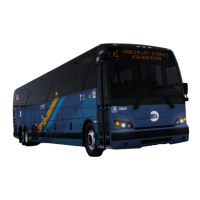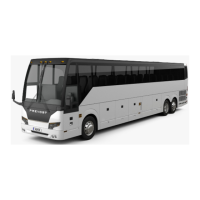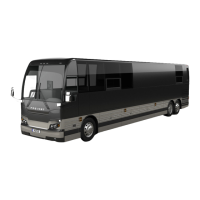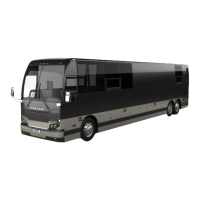SECTION 12: BRAKE AND AIR SYSTEM
DOB 1300-1556 | X3-45 Commuter PA-1648 Maintenance Manual Section 12 revised Jan 2021
2. Safely support vehicle at the recommended
body jacking points.
To gain access to a given brake chamber, the
corresponding wheel can be removed (refer
to Section 13: "Wheels, Hubs and Tires").
3. Exhaust compressed air from air system by
opening the drain valve of each tank.
4. For the drive and tag axles brake chambers,
manually release spring brakes (refer to
“Emergency/Parking Brake Manual
Release" procedure in this section).
5. Remove clamp ring, remove and discard the
existing diaphragm. Install the new
diaphragm squarely on body.
6. Reverse the procedure for assembly. Tap
clamp ring to ensure proper seating. Check
for proper operation before placing vehicle in
service.
20. ANTI-LOCK BRAKING SYSTEM (ABS)
This system has been designed to ensure
stability and permit steering control of vehicle
during hard braking, and to minimize its
stopping distance whatever the road conditions
are. On slippery roads and generally in
emergency situations, over-braking frequently
induces wheel lock. The anti-lock braking
system provides maximum braking performance
while maintaining adequate steering control on
slippery roads.
The ABS continuously monitors wheel behavior
during braking. Sensors on each wheel of front
and drive axles (tag axle is slave to drive axle)
transmit data to a four channel electronic
processor which senses when any wheel is
about to lock. Modulator valves quickly adjust
the brake pressure (up to 5 times per second) to
prevent wheel locking. Each wheel is therefore
controlled according to the grip available
between its tire and the road.
With this device, the vehicle is brought to a halt
in the shortest possible time, while remaining
stable and under the driver's control.
Since the braking system has dual circuits, the
ABS is also provided with a secondary system
should a fault develop in the ABS. Anti-lock
systems are a parallel system which does not
hinder brake functioning in case of failure.
Braking system functions in normal, non-anti-
lock controlled operation during ABS system
failure.
The ABS system consists of two diagonally
related circuits, only the half of the system which
has sustained damage or other fault is switched
off (i.e. wheels return to normal non-ABS
braking). The other diagonal half remains under
full ABS control.
20.1 TROUBLESHOOTING AND TESTING
For detailed information, troubleshooting and
testing refer to Bendix booklet “Bendix Service
Data EC80 ESP Controller (SD-13-4986)” found
on the Technical Publications USB flash drive
and web site.
20.2 ABS COMPONENTS
The main components of the ABS system are
listed hereafter. Refer to each component for its
specific function in the system and for proper
maintenance.
20.3 BENDIX EC-80 CONTROLLER
This control unit, a.k.a ABS module, is located
in the front electrical and service compartment.
According to the data transmitted by the
sensors (number of pulses/sec is proportional to
the speed of each wheel), the electronic control
unit determines which wheel is accelerating or
decelerating. It then establishes a reference
speed (average speed) from each wheel data,
and compares the speed of each wheel with this
reference speed to determine which wheel is
accelerating or decelerating.
As soon as wheel deceleration or wheel slip
threshold values are exceeded, the electronic
control unit signals a solenoid control valve to
limit the excessive brake pressure produced by
the driver in the appropriate brake chamber.
For further detail, consult Bendix Service Data
SD-13-4986.
Maintenance

